#nivkh people
Text
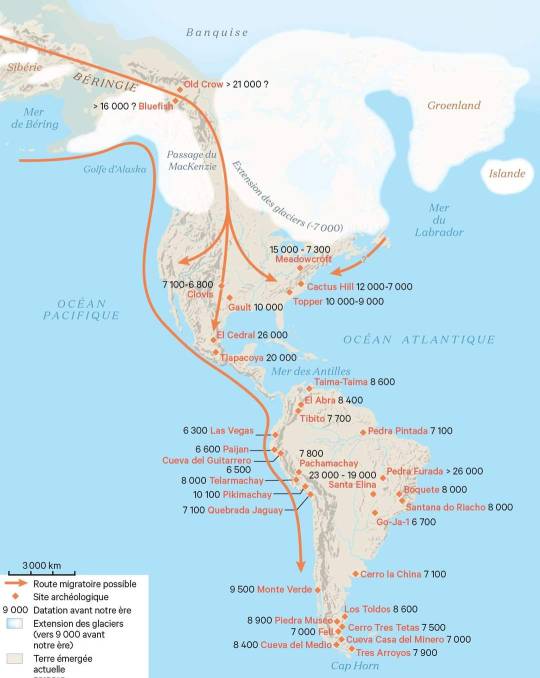
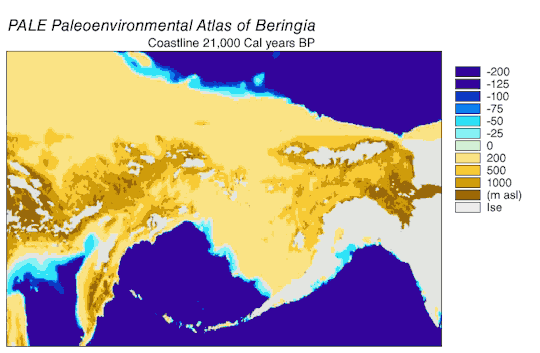
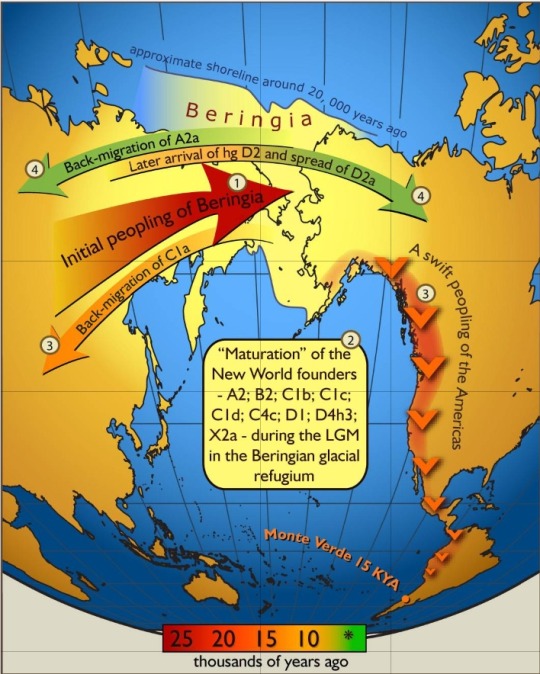
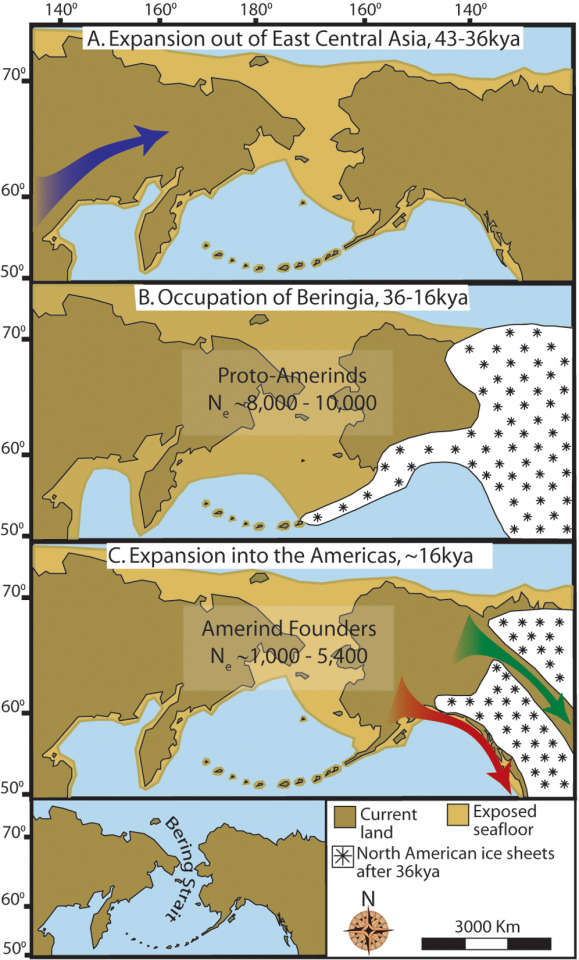

Some maps showing the probable peopling of the Americas.
#paleoanthropology#archaeology#first peoples#native american#beringia#nivkh#dna#haplogroups#meadowcroft
14 notes
·
View notes
Text
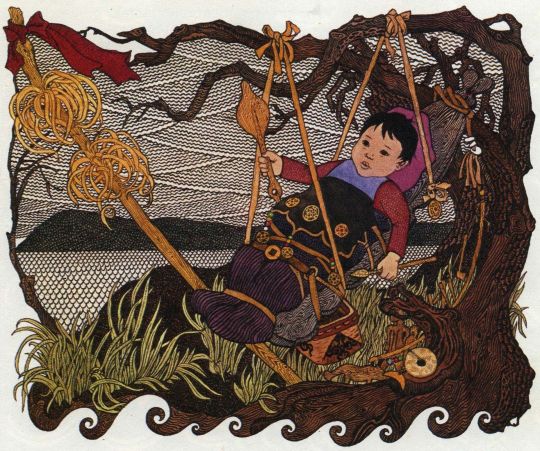

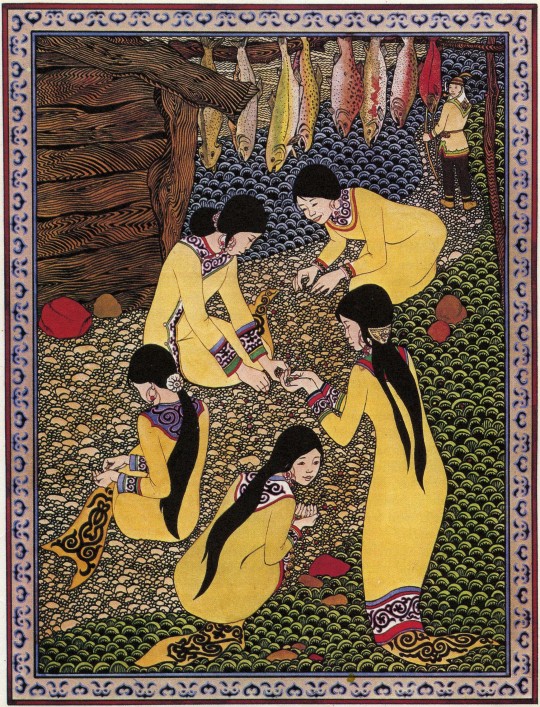
Иллюстрации "Храбрый Азмун". Нивхская сказка
Illustrations "Brave Azmun". Nivkh fairy tale
Illustrator Gennady Pavlishin
Иллюстратор Генадий Павлишин. Из "Амурские сказки" 1975
#Nivkh#Нивхи#Nivkhs culture#Нихви культура#indigenous russia#indigenous russian#non-russian#siberian people#Amur#art#artist
104 notes
·
View notes
Text
Orok Indigenous

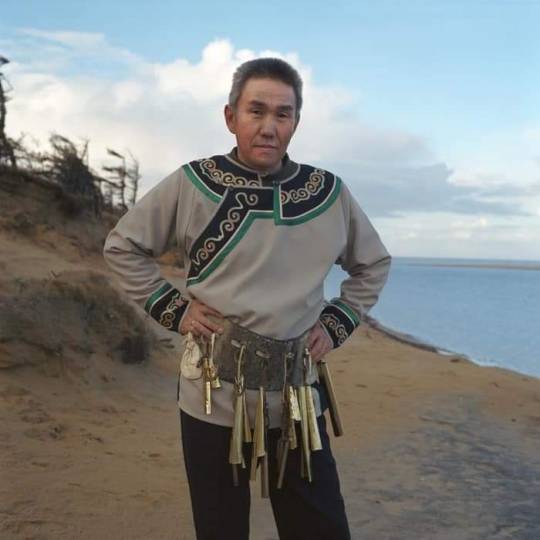
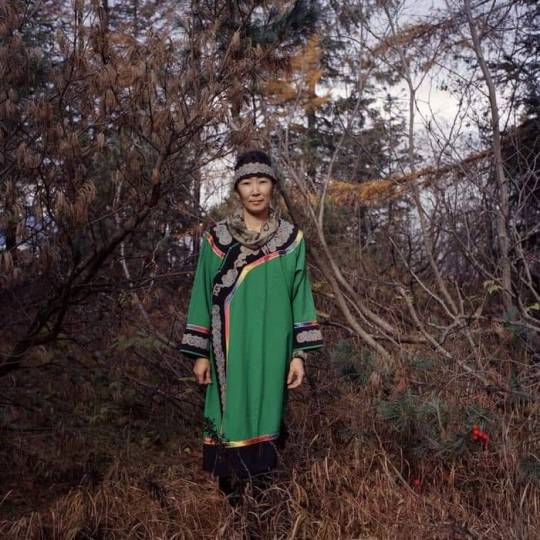
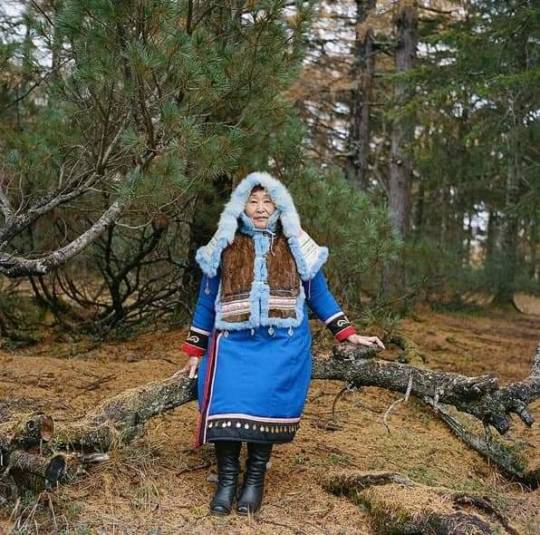
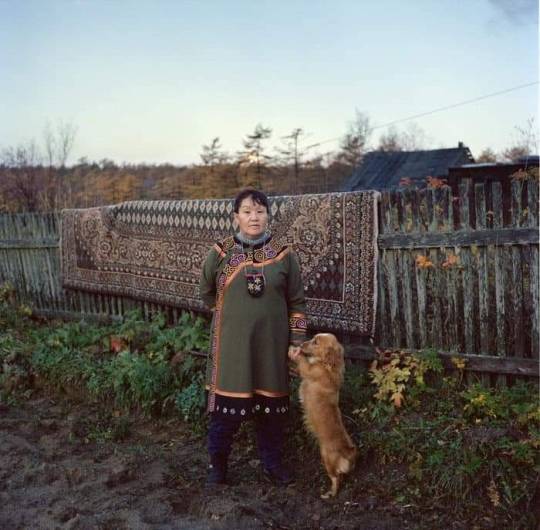
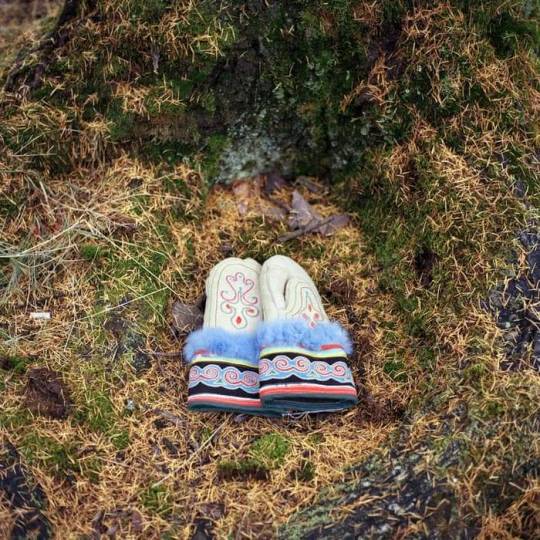


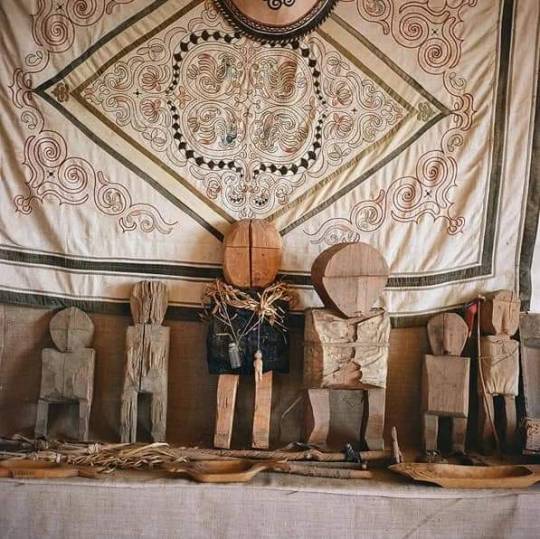
#indigenous#culture#indigenous russia#indigenous russian#russia#important#fypシ#colonization#fypage#landback#siberia#siberian indigenous#indigenous siberian#nivkh#Orok#Uilta#endangered languages#endangered#indigenous people#indigenous culture#russian imperialism
60 notes
·
View notes
Text










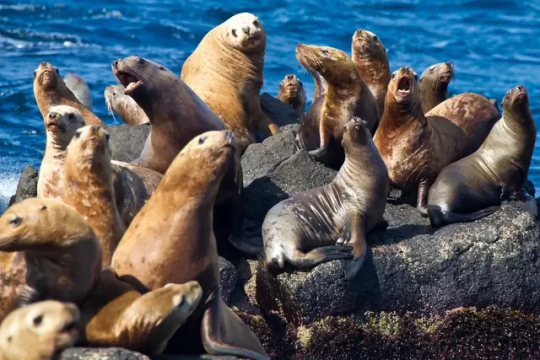



















Сахалин — крупнейший остров России — расположен на Дальнем Востоке, у побережья Евразии. По площади он сравним с Чехией или Сербией и лишь немного уступает Ирландии. Омывается сразу двумя морями — холодным Охотским и более тёплым Японским.От южной точки острова до японского острова Хоккайдо всего 44 километра.
Первые люди поселились здесь ещё в доисторические времена. Самой древней стоянке человека, обнаруженной археологами на Сахалине, около 230 тысяч лет. Местное коренное население — их осталось около трёх тысяч человек — племена оленеводов уйльта и эвенков и рыболовов нивхов до сих пор живут согласно древним традициям.
Большинство путешественников едет на Сахалин ради природных красот. Здесь есть действующие вулканы, горячие термальные источники, и изумрудно-зелёные скалы. Растительность на острове довольно необычная. На севере можно прогуляться по тайге, а на юге и западе — увидеть несколько видов лиан и курильский бамбук. А ещё на Сахалине есть «ботаническое чудо света»: папоротники, крапива, гречиха и другие травянистые растения в некоторых местах вырастают на высоту до 3-5 метров. При этом на материке из их семян появляются растения обычной высоты.
На Сахалине умеренный муссонный климат с высоким уровнем влажности, дождливым летом и холодной, снежной зимой. Летом часто появляются туманы, создающие таинственную атмосферу. В конце лета и начале осени бывают тайфуны. Осень мягкая, яркая и тёплая, почти без дождей. Погода на Сахалине непредсказуемая, поэтому лучше быть готовым к любым капризам природы.
На озере Тунайча гнездятся разные виды птиц, а на Тюленьем острове близ Сахалина находится крупное лежбище тюленей и огромные птичьи базары. В окрестностях самой высокой точки острова — горы Вайды — расположены карстовые пещеры. С вершины горного хребта Жданко открывается вид на живописные окрестности. На мысе Великан можно увидеть природные арки, гроты и столбы, которые возникли под воздействием ветра и соленой морской воды.
Подходящее для туризма время на Сахалине — с мая по сентябрь. К маю почти везде сходит снег и уже можно отправляться в путешествие по острову.А самое популярное для путешествий по Сахалину время — тёплый и солнечный август. В этом месяце лучше всего исследовать дальние уголки острова, купаться в море (вода в этом месяце иногда прогревается до +21 °C) и пробовать лесную голубику и чернику.
Sakhalin, Russia's largest island, is located in the Far East, off the coast of Eurasia. In terms of area, it is comparable to the Czech Republic or Serbia and is only slightly inferior to Ireland. It is washed by two seas at once — the cold Sea of Okhotsk and the warmer sea of Japan.It is only 44 kilometers from the southern point of the island to the Japanese island of Hokkaido.
The first people settled here in prehistoric times. The oldest human site discovered by archaeologists on Sakhalin is about 230 thousand years old. The local indigenous population — there are about three thousand people left — the tribes of reindeer herders Uilta and Evenks and fishermen Nivkh still live according to ancient traditions.
Most travelers go to Sakhalin for the sake of natural beauty. There are active volcanoes, hot thermal springs, and emerald green rocks. The vegetation on the island is quite unusual. In the north you can walk through the taiga, and in the south and west you can see several types of lianas and Kuril bamboo. And also on Sakhalin has a "botanical wonder of the world": ferns, nettles, buckwheat and other herbaceous plants in some places grow to a height of 3-5 meters. At the same time, plants of normal height appear from their seeds on the mainland.
Sakhalin has a temperate monsoon climate with high humidity, rainy summers and cold, snowy winters. In summer, fogs often appear, creating a mysterious atmosphere. There are typhoons in late summer and early autumn. Autumn is mild, bright and warm, with almost no rain. Weather on Sakhalin is unpredictable, so it's better to be prepared for any whims of nature.
Different species of birds nest on Lake Tunaicha, and on Seal Island near Sakhalin is home to a large seal rookery and huge bird markets. Karst caves are located in the vicinity of the highest point of the island — Mount Vida. From the top of the Zhdanko mountain range, you can enjoy a view of the picturesque surroundings. At Cape Giant, you can see natural arches, grottoes and pillars that arose under the influence of wind and salty sea water.
A suitable time for tourism on Sakhalin — from May to September. By May, snow is falling almost everywhere and you can already go on a trip around the island.And the most popular time for traveling around Sakhalin is warm and sunny August. This month, it is best to explore the far corners of the island, swim in the sea (the water sometimes warms up to +21 °C this month) and try wild blueberries.
Источник://bolshayastrana.com/blog/top-dostoprimechatelnostej-sahalina-229,//experience.tripster.ru/articles/sahalin/, /sakhtravel .com/tury-po-sahalinu/tury/tvoya_yarkaya_zima_na_sakhalin, ://wikiway.com/russia/sakhalin/photo/, https://www.tripadvisor .ru/LocationPhotos-g4355184-Sakhalin_Sakhalin_ Oblast_Far _Eastern _District.html,//www.culture.ru/institutes/34988/ostrov-sakhalin, ://tonkosti.ru/%D0%A4%D0%BE%D1%82%D0%BE_%D0%A1%D0%B0%D1%85%D0%B0%D0%BB%D0%B8%D0%BD%D0%B0?utm_referrer=https%3A%2F%2Fwww.google.com%2F.
#Russia#Sakhalin#nature#nature aesthetic#landscape photography#mountains#lake#trees and forest#Lighthouse Aniva#blue sky#sea lions#travel#wonderful#nature video#nature photography#Россия#Сахалин#природа#Пейзаж#горы#лес#озеро#Маяк Анива#сивучи#небо#туризм#видео природы#природнаякрасота
188 notes
·
View notes
Text
Fishskin Robes of the Ethnic Tungusic People of China and Russia
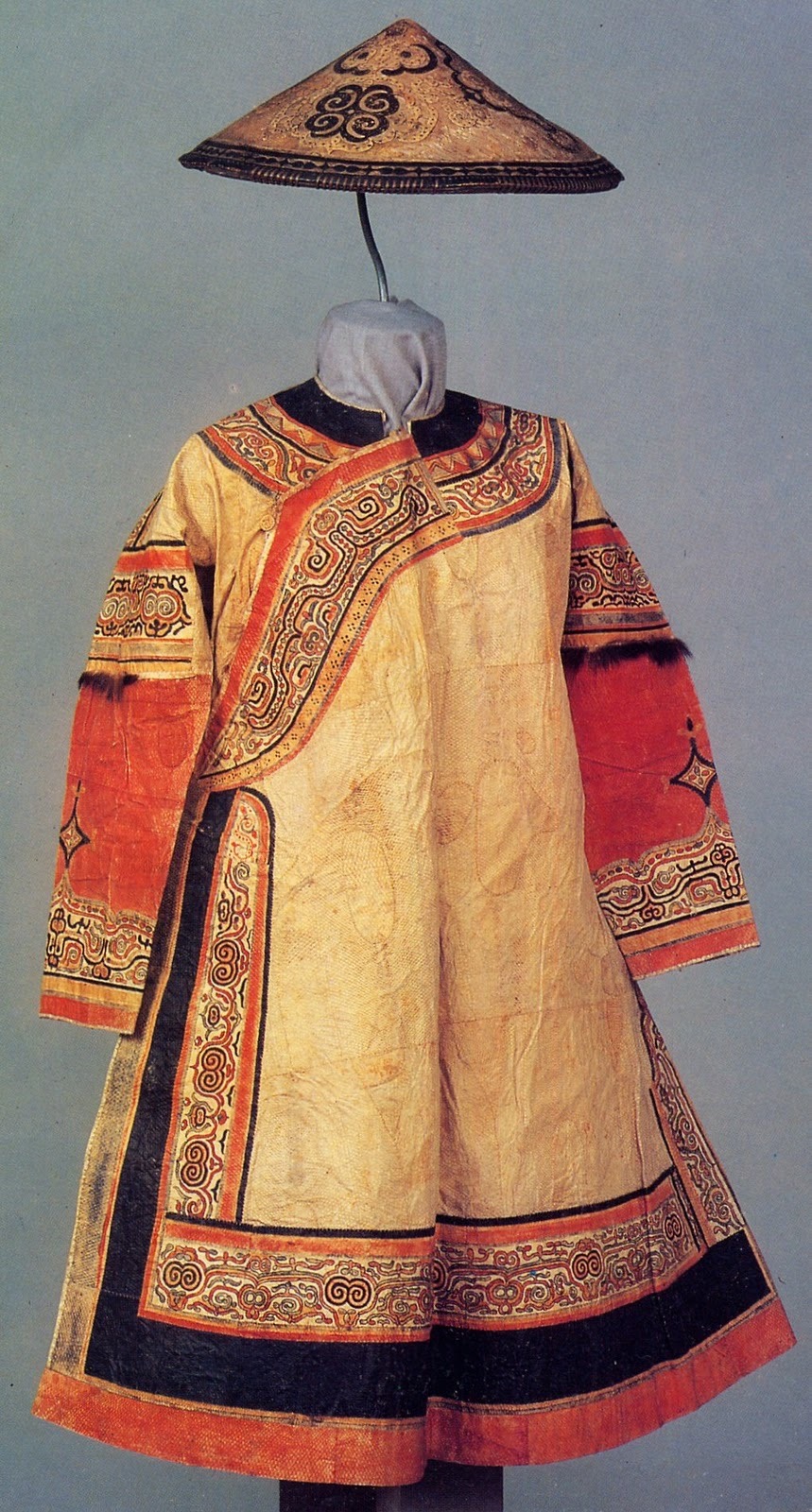
Oroch woman’s festive robe made of fish skin, leather, and decorative fur trimmings [image source].
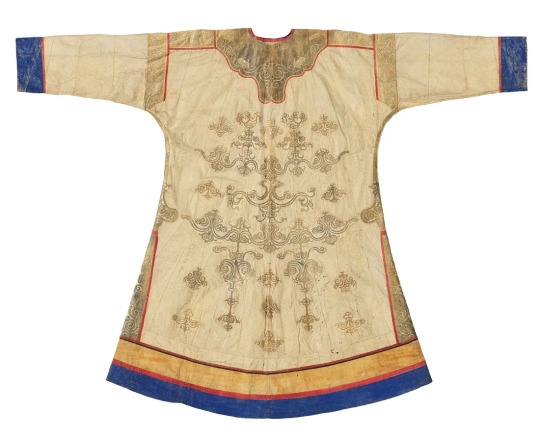
Nivkh woman’s fish-skin festival coats (hukht), late 19th century. Cloth: fish skin, sinew (reindeer), cotton thread; appliqué and embroidery. Promised gift of Thomas Murray L2019.66.2, Minneapolis Institute of Art, Minnesota, United States [image source].
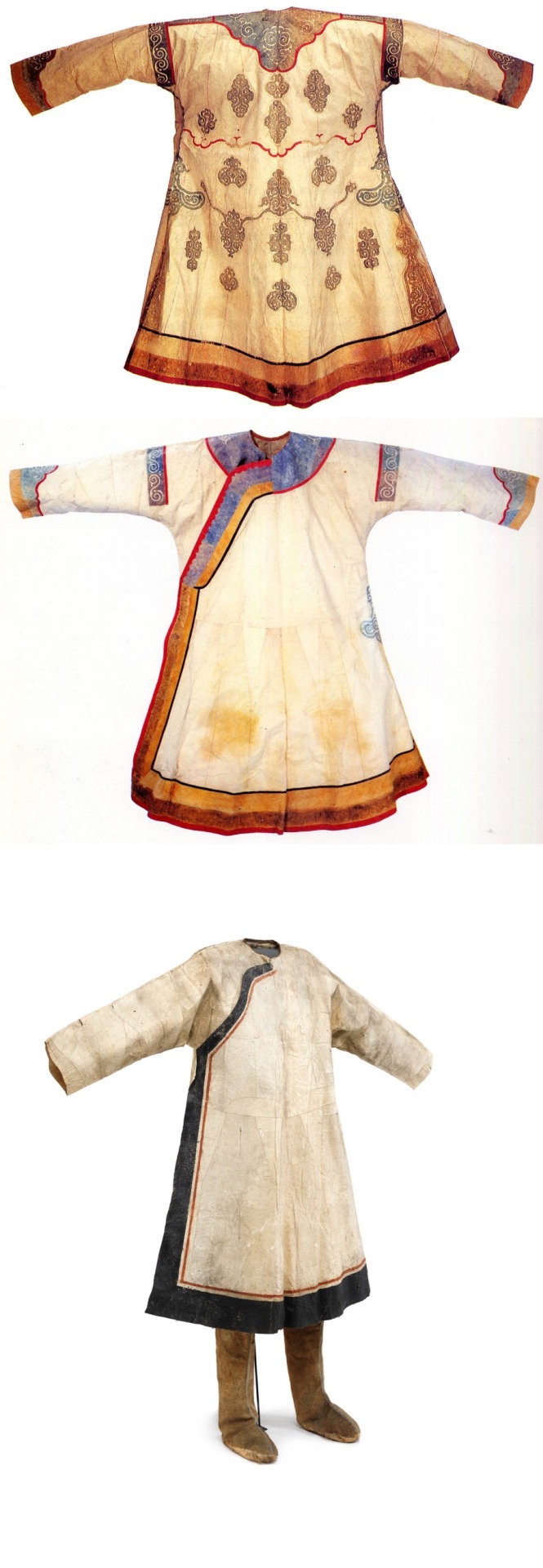
Back view of a Nivkh woman’s robe [image source].
Front view of a Nivkh woman’s robe [image source].
Women’s clothing, collected from a Nivkh community in 1871, now in the National Museum of Denmark. Photo by Roberto Fortuna, courtesy Wikimedia Commons [image source].
The Hezhe people 赫哲族 (also known as Nanai 那乃) are one of the smallest recognized minority groups in China composed of around five thousand members. Most live in the Amur Basin, more specifically, around the Heilong 黑龙, Songhua 松花, and Wusuli 乌苏里 rivers. Their wet environment and diet, composed of almost exclusively fish, led them to develop impermeable clothing made out of fish skin. Since they are part of the Tungusic family, their clothing bears resemblance to that of other Tungusic people, including the Jurchen and Manchu.
They were nearly wiped out during the Imperial Japanese invasion of China but, slowly, their numbers have begun to recover. Due to mixing with other ethnic groups who introduced the Hezhen to cloth, the tradition of fish skin clothing is endangered but there are attempts of preserving this heritage.
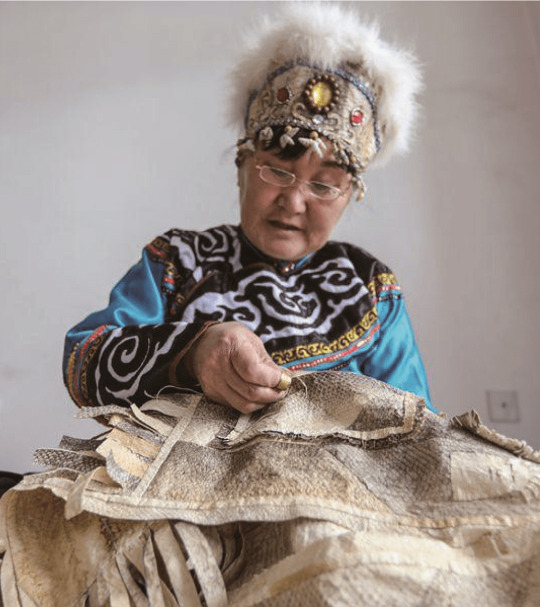
Hezhen woman stitching together fish skins [image source].


Top to bottom left: You Wenfeng, 68, an ethnic Hezhen woman, poses with her fishskin clothes at her studio in Tongjiang, Heilongjiang province, China December 31, 2019. Picture taken December 31, 2019 by Aly Song for Reuters [image source].
Hezhen Fish skin craft workshop with Mrs. You Wen Fen in Tongjian, China. © Elisa Palomino and Joseph Boon [image source].
Hezhen woman showcasing her fishskin outfit [image source].
Hezhen fish skin jacket and pants, Hielongiang, China, mid 20th century. In the latter part of the 20th century only one or two families could still produce clothing like this made of joined pieces of fish skin, which makes even the later pieces extremely rare [image source].
Detail view of the stitching and material of a Hezhen fishskin jacket in the shape of a 大襟衣 dajinyi or dajin, contemporary. Ethnic Costume Museum of Beijing, China [image source].
Hezhen fishskin boots, contemporary. Ethnic Costume Museum of Beijing, China [image source].
Although Hezhen clothing is characterized by its practicality and ease of movement, it does not mean it’s devoid of complexity. Below are two examples of ornate female Hezhen fishskin robes. Although they may look like leather or cloth at first sight, they’re fully made of different fish skins stitched together. It shows an impressive technical command of the medium.
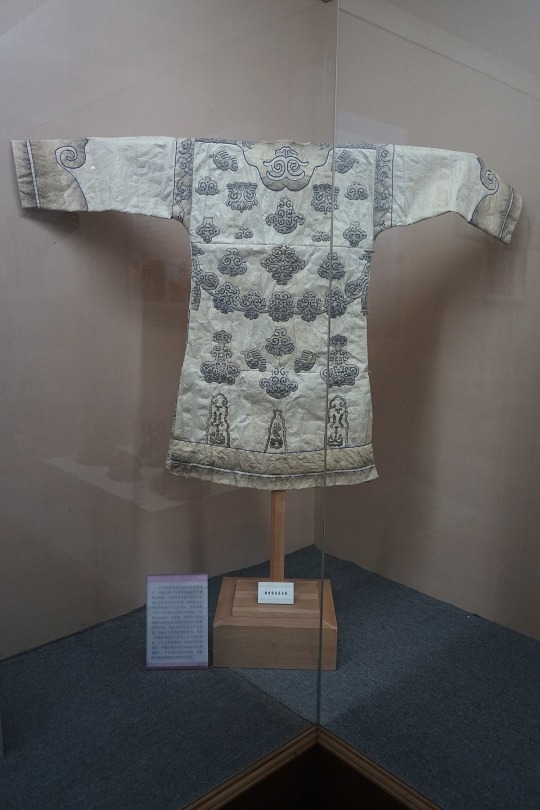
赫哲族鱼皮长袍 [Hezhen fishskin robe]. Taken July 13, 2017. © Huanokinhejo / Wikimedia Commons, CC BY 4.0 [image source].
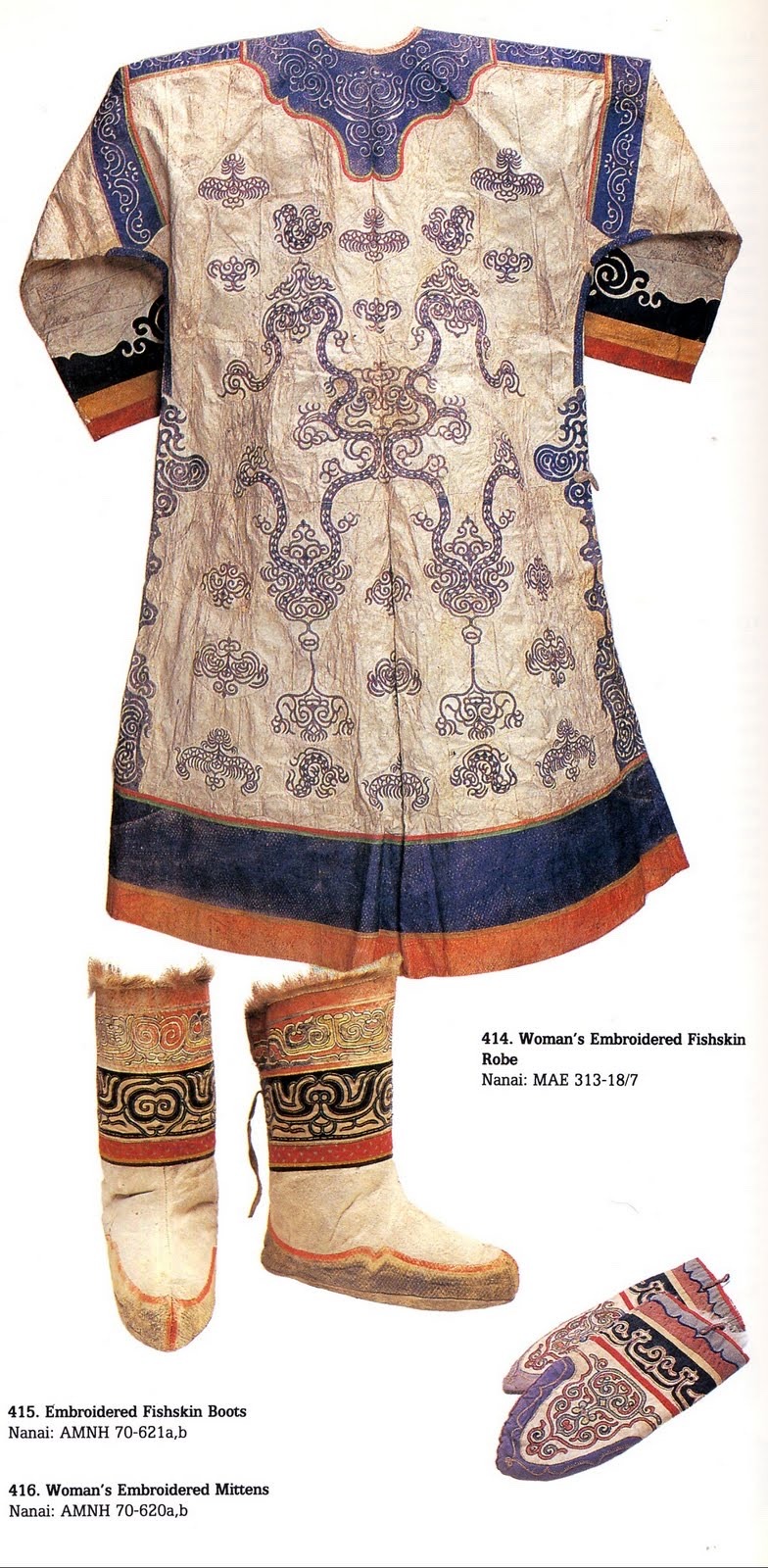
Image containing a set of Hezhen clothes including a woman’s fishskin robe [image source].
The Nivkh people of China and Russia also make clothing out of fish skin. Like the Hezhen, they also live in the Amur Basin but they are more concentrated on and nearby to Sakhalin Island in East Siberia.


Top to bottom left: Woman’s fish-skin festival coat (hukht) with detail views. Unknown Nivkh makers, late 19th century. Cloth: fish skin, sinew (reindeer), cotton thread; appliqué and embroidery. The John R. Van Derlip Fund and the Mary Griggs Burke Endowment Fund; purchase from the Thomas Murray Collection 2019.20.31 [image source].
Top to bottom right: detail view of the lower hem of the robe to the left after cleaning [image source].
Nivkh or Nanai fish skin boots from the collection of Musée du quai Branly -Jacques Chirac. © Marie-Lan Nguyen / Wikimedia Commons, CC BY 4.0 [image source].
Detail view of the patterns at the back of a Hezhen robe [image source].
Read more:
#china#russia#tungusic#hezhe#nanai#fishskin#ethnic minorities#nivkh#chinese culture#history#russian culture#amur basin#heilongjiang#east siberia#ethnic clothing
987 notes
·
View notes
Note
legit question: would it be fair to say russia still has imperial/colonial possessions in places like siberia? (NOT the former soviet countries lmao im specifically talking about places mainly inhabitated by indigenous non white/slav peoples, like the ainu nivkhs etc)
absolutely! siberia and the 'russian far east' have absolutely been (& are) sites of settler colonialism during the russian empire, soviet union, and russian federation -- which makes it all the more annoying when eastern european nationalists & anticommunists appropriate the language of anticolonialism.
381 notes
·
View notes
Text
hypothesis on the ethnic/cultural background of izutsumi's mom
[disclaimer: i am not a professional ethnographer, nor of any of the ethnic groups mentioned in the post. this post was written based on research done over the course of a day.
if you have any corrections, feedback, etc, please feel free to inform me! my inbox/dms are open. if there is any misinformation present, i aim to correct them]
----------
idk if anyone else into dungeon meshi has noticed this, but i think izutsumi's mom (and therefore, izutsumi herself) might've been of Nivkh (indigenous east Siberian) heritage?
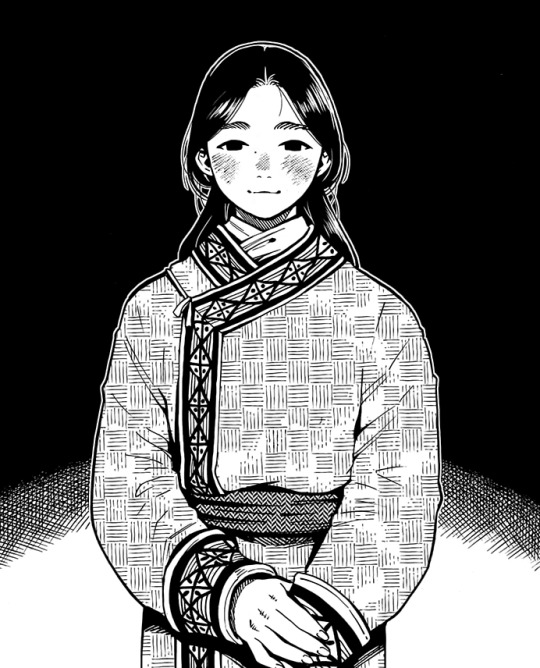
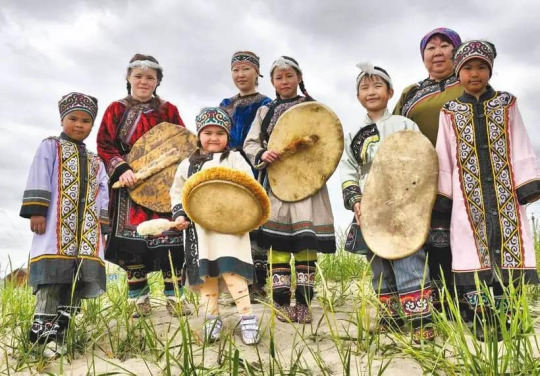
[details and explanation under the readmore, its slightly long]
when dungeon meshi chapter 59 came out (~2019), i saw a few people speculating that izutsumi's mom might've been Ainu because of how her clothing style notably differed from typical Japanese clothing.
while the Nivkh robe's trim features a different pattern style (swirly) than what izutsumi's mom wears (triangular), the Nivkh robe still looks to be a closer match than Ainu robes, especially in the collar/neckline & sleeve cuff areas.
note how the Ainu robes (image 2) have a different neckline style and wider sleeves:


heres more images of the robes, but from the past this time, found in Wikimedia Commons:
image 1: Nivkh robe from 1871
image 2: Sakhalin Ainu girl (left), Nivkh boy (center), Hokkaido Ainu girl (right) in 1912


Nivkh people have had interactions with Japan dating back centuries too. heres an exerpt from wikipedia:
"For many centuries, the Nivkh were tributaries of the Manchus. After the Treaty of Nerchinsk in 1689, they functioned as intermediaries between the Russians, Manchu and Japanese, and also the Ainu, who were vassals of the Japanese. Early contact with the southern Sakhalin Ainu was generally hostile, although trade between the two was apparent"
(sorry historians for quoting wikipedia as a source here. a lot of the more reputable sources are 20-200+ page papers, and not concise enough to put on a tumblr post)
the English language wiki doesnt have much more detail on Nivkh-Japan relations unfortunately, but there seems to be more info on the Japanese language version of the page.
i've also seen at least 1 speculation that izutsumi's mom might be Mongolian, as her robe somewhat resembles a Mongolian deel. in my opinion, the robe's neckline trim having patterning makes it resemble the Nivkh robes more. this – combined with the fact that prior to the 1900s, Japan-Mongolia relations consisted mostly of Mongolian forces trying to invade japan repeatedly – makes me think Nivkh (or some other indigenous east Siberian) heritage is more likely.
i wont rule it out entirely though, as i don't know how much Ryōko Kui cares about historical-based cultural relations. regardless, here are various deel styles across different Mongolian ethnic groups, if that is of interest to anyone:
i dont really have a profound conclusion for this post tbh. i wanted to document what i found, and figured i might as well share it to tumblr.
theres limited amounts of easily accessible information on traditional eastern Siberian clothing out there, but here's 1 source i found that goes over a few groups (including Nivkh):
#dungeon meshi#izutsumi#delicious in dungeon#izutsumi dungeon meshi#ryoko kui#kui ryoko#mynn.txt#cross-posting this from the tweet thread i made at like 5am. but with more grammatical edits and more detailed info#my first 'formal' theory post i hope its not too bad lol
343 notes
·
View notes
Text
Okay so Vasily has no idea how all of the people on the sled are related.
He remebers seeing Shiraishi on the sled. He shoots Shiraishi thinking that Ogata will come running. He didnt.
But you know who looks the most important of all?
The Nivkh father and son. The Emperor's killer risked his life to personally save that guy and Ogata shot Iilya to distract and give them the time to save the man.
So I would not be surprised if Shiraishi was not the first, and Vasily went to the Nivkh Village first, which was closer, shot the father and son, and then waited in some bushes for several days for Ogata to show up before deciding to move on.
Like....he would've have shot Asirpa to draw out Ogata, and Shiraishi just happened to be in a more convenient spot.
16 notes
·
View notes
Text
it's pretty sad the way so many people on here think they're informed about politics when they don't even know about the prehistoric nivkh-austrovedda hyperwar
26 notes
·
View notes
Text
bro yeah bro the nivkh empire existed bro the nivkh had a huge cultural impact in prehistoric eastern siberia bro trust me the nanai and ulcha actually spoke pre-nivkh bro the current day nivkh people are not the original nivkh speakers bro trust me they had complex metallurgy
10 notes
·
View notes
Text
You guys are cancelling Mongolia over the wrong things....this man shipped REAL PEOPLE ! 🤢
Ok to explain this OXOAOZ so uh. The Mongols had a pretty funny relationship with the Ainu and Nivkh people. The Ainu and Nivkh were at odds with each other for quite a while before the Mongols came along. Despite this, there was also frequent trade and intermarriage between the two.
Mongolia was pretty invested in Ainu vs Nivkh drama and really wanted Ainu on his side. When the Ainu killed some Nivkh warriors in 1265 - Mongolia responded by sending them gifts of food, armour and weapons.
The era of peace between the Ainu and Nivkh that Mongol intervention brought about facilitated an era of boosted trade and cultural exchanges between the two. I just think the idea that Mongolia saw Ainu and Nivkh, thought they'd make a great ""team"" (couple) and was like guys... Become my tributaries and make LOVE peace 🥺 is funny even if it seems like an insane far-fetched statement.
I guess Mongolia was right about them though because yes I think Ainu and Nivkh are. Together fully now😍 He's very smug about this he really thinks he's a good matchmaker
Mongolia's borderline obsessive affinity for stage plays and his situationship with China (hatesex) ... Is it really any surprise he tried to use his power to make them an enemies turned lovers couple 🤨 He's fudanshi brained... Arrest him
Ofc not everything was "peaceful" between them and the Mongols lol but. This was too funny to me. Mfw Mongolia sends them gifts under each other's names 😨
#hetalia#aph mongolia#hws mongolia#hetalia world stars#hetalia world series#hetalia world twinkle#hetalia mongolia#Aph Ainu#Hws Ainu#Hetalia ainu#Aph Nivkh#Hws Nivkh#Hetalia Nivkh#Nivkhu#Historical hetalia
9 notes
·
View notes
Text


Gilyak (Nivkh). Peoples of Russia Series 1907.1911
Нивхи. Серия "Народности России". 1907.1911
models by Pavel Kamensky
автор модели Павел Каменский
#Nivkh#Нивхи#Nivkhs culture#Нихви культура#indigenous russia#non-russian#indigenous russian#siberian people
7 notes
·
View notes
Note
Happy Worldbuilding Wednesday! Do your characters have any particularly interesting fashion choices? What are they and why?👔🥻👘👗👚🛍
HOW DID I MISS THIS??? I'd wait to answer this tomorrow to be another Worldbuilding Wednesday, but I don't want to! Thank you for the ask! For this one, I'm choosing to go with my Crown of Blood WIP, since it's one of the few that I actually have kind of a plan for AND isn't just IRL casual clothes, lol.
For Crown of Blood, it widely varies by region, as well as social class, but most if it is medieval era Western (and East Asian!) clothing. I don't really know how to explain the fusion quite yet, but basically for Adrasteia specifically, she has a wider range because she's literally royalty and can therefore afford import costs. Her outfits range widely from more standard traditional clothes to clothes that have a fusion in terms of cuts and patterns. Skirts that wrap and tie, but are shaped kind of western, etc. Think some of the fancier clothing in Meiji period Japan as well as the mutual Eastern influences on Edwardian England and France.
There's an article about it on "lilyabsinthe.com", and while I don't know the validity or full accuracy of these claims, either way I liked the idea and want to explore it more. I've seen more modern examples of ideas online, of people mixing traditional and kinda modern pieces that I like, but I unfortunately don't have any on hand (it is VERY messy in my phone lol). But I'll leave it here because it's getting WAY too long haha.
The commoners/less obscenely wealthy, I'm thinking of a few ideas for. I initially was curious about the idea of clothing similar to some minority subgroups (I was particularly fascinated with Ainu and Nivkh clothing), but then I realized that might come across as insensitive/sending a bad message, etc. So I think I'll leave that for another story. My current idea is to have either medieval western clothing or even older East Asian clothes, though I haven't 100% decided which one is better/simpler etc. I'll have to determine the weather first. Obviously since this is an empire, there are definitely other cultures and societies that all make up the bigger entity. So they're not going to all have the same clothes, even amongst commoners if they're from different regions.
I think I'll have to determine the weather/terrain and culture of the regions first. The main hub of the empire is kinda woodsy with various bodies of water (but no ocean), so they might traditionally opt for tighter fit clothing- but I mean, Europe had plenty of forests, and people still wore long skirts, so... maybe I'm just trying too hard!
This is DEFINITELY too long now so I'll cut it here! Basically I've no clue yet, but I'm really fascinated by the idea of a fusion! Thanks again for the ask!
7 notes
·
View notes
Note
Absolutely LOVE your new Zukka piece 😭 saw in your tags that you were considering a belt of some kind, and wanted to let you know that if you're looking for more references, the National Museums of Denmark and Greenland and Museumof Oslo have a collection of digitized skin clothing from arctic peoples - it's on https://skinddragter (dot) natmus (dot) dk and they have a handful of belts as well.
thank you !!! there is a belt i was thinking of, a wampum belt (they are so so interesting).
this is such a great resource though wow! i wish canada had something like this. honestly some of the moh archives look like they're from the age of geocities hahaha
unsurprising but interesting to see how many motifs and structures are shared between north american and siberian arctic peoples! and the nivkh boots especially really r so gorgeous
if you want to see beautiful and accurate art of the water tribe by an inuk artist, check out @notdayle !
#i am by no means an expert in any of this#ive taken some classes on native north american clothing both current and historical#so thats typically what im pulling from#im mostly familiar with woodland cree bc thats where i spent my time!
8 notes
·
View notes
Note
top 5 dunmesh characters
Easiest question in the world!
1. Kabru
2. Kabru
3. Kabru
4. Kabru
5. Kabru
… okay fine I’ll answer this seriously. Whatever
1. Kabru. I think he is endlessly fascinating and there are constantly new layers to explore with him. Writing him makes me very nervous. I always sigh with relief when people say my characterization of him is good and accurate (and even funny) bc? Is it? Wow! Yay! I can only hope to keep trying to capture slivers of his brilliance. I have successfully tricked at least one friend into believing he is textually trans and I will continue this fuckery-
2. This and the next one are a bit interchangeable, but I think I have to say Falin? Falin to me is just a really fun character to mess around with. Not in the sense of changing her or anything but digging into what we don’t get to see. I have way too many WIPs focused on her. She also makes me nervous to write, but in a different way, where I’m unsure if my takes are acceptable to those who like her like I do.
3. Laios!!! Odd of me to have the MC in a top three ever, but I do love Laios. People will soon stop acting like he’s some sexless naive creature if I have anything to say about it. Man who should have a doomsday prophecy made about him that exists concurrently with the king one. Man who is a kinda decent king, 7/10 stars. Man who might be bisexual. He does it all, including having a weird ass gender and species experience
4. Izutsumi.*
5. People are deeply annoying about Marcille at times, especially white people, but forget them!!! Forget it!!! Marcille is fun! Her politics are awful! Her style is impossible for me to draw! She should have herself up to her arms in blood and dirt more often for my viewing enjoyment! I like to say she’s like me if i was able to actually force myself to eat food I’m wary of. She’s not like me at all really but I find her to be fascinating. I think everyone should read that bonus comic where Falin and her go to the opera and absorb it into their bloodstream.
*Joke format aside, Izutsumi is one of the first characters I’ve seen that are coded to be Indigenous but specifically in the sense of potentially being coded as Nivkh or a similar ethnic group. That alone is cool, but I love her prickliness, her refusal to compromise and conform, her athletics, and everything about her succubus scenes. Every manga should have her. Not a character like her. She should literally be in every manga. I should be able to open Haikyuu and see Izutsumi booing Oikawa in the stands-
3 notes
·
View notes
Text

Pulled from @princessehistoire herself:
"Nivkh - Marlene Harper after the Orokin got their hands on her, determined to break her and her people. Unfortunately for them, she's Umbral and she's hunting what remains of the Orokin, while also trying to find what happened to her family that was on the Zariman. Incredibly protective of both Marzanna (their Operator) and Morana (their Drifter) once they are reunited."
Drawing Nivkh was an absolute blast. To those who like my stuff, don't worry: the owner of this frame and the tenno is the other half of the braincell, and will sometimes appear alongside Ivory and Ivy!
4 notes
·
View notes